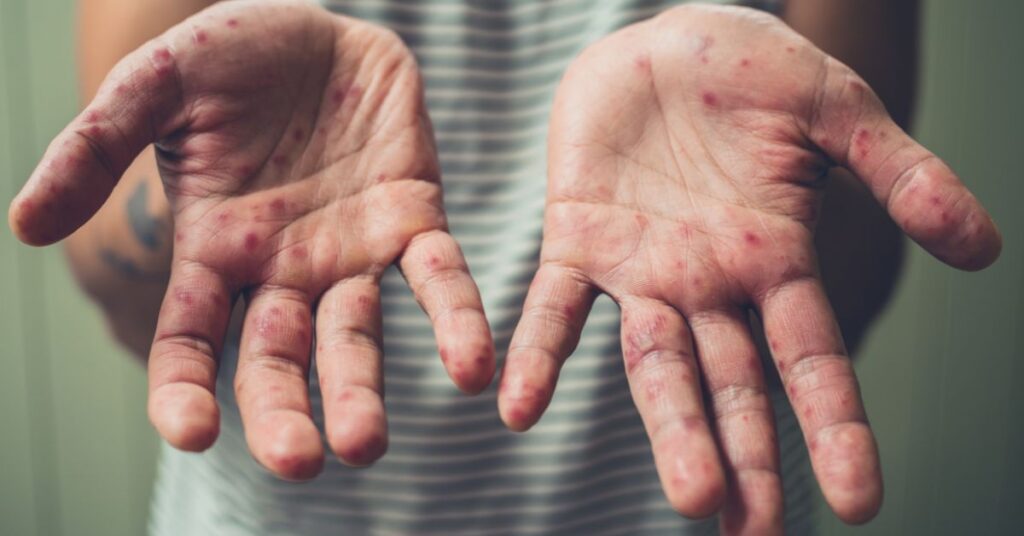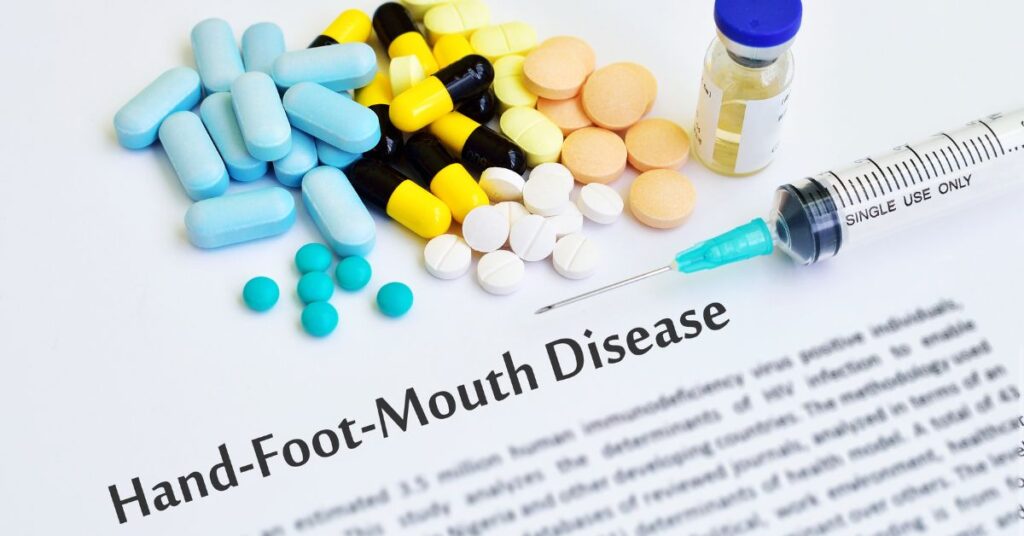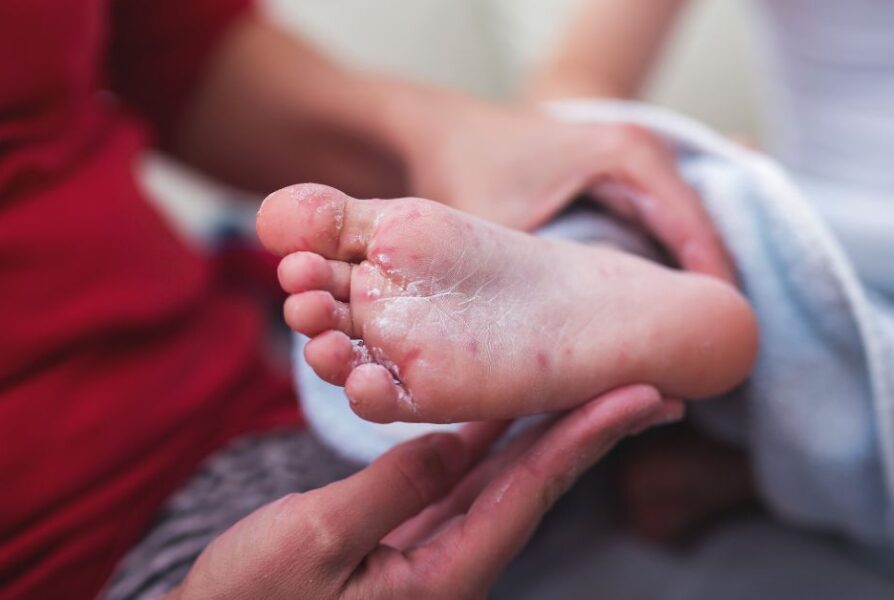Hand, foot, and mouth disease (HFMD) is a contagious viral infection most commonly seen in young children. While it is often mild, the symptoms can be uncomfortable and sometimes concerning for parents and caregivers. Here, we’ll explore what causes HFMD, the symptoms, how to manage it at home, and tips on preventing it from spreading.
What Is Hand, Foot, and Mouth Disease?
Hand, foot, and mouth disease is caused by a group of viruses called enteroviruses, with the most common being the Coxsackievirus A16.
HFMD primarily affects children under the age of 5, although older children, teenagers, and adults can also catch the virus. Outbreaks are common, particularly in places where children are in close quarters, like daycare centres and schools. While the infection can look alarming, HFMD is usually a mild illness that clears up on its own within a week to 10 days.
The virus spreads through contact with bodily fluids, including nasal discharge, saliva, and fluid from blisters. Because the disease is so contagious, it can spread quickly among children, especially if hygiene practices are not strictly observed.
Recognising Symptoms of HFMD
Early symptoms of hand, foot, and mouth disease resemble many other viral infections, such as the common cold or the flu. Here’s what to look out for:
1. Fever: One of the first signs of HFMD is often a mild fever.
2. Sore Throat and Reduced Appetite: Children may complain of a sore throat and show less interest in eating or drinking, sometimes even before visible symptoms appear.
3. Mouth Sores: Painful red spots appear in the mouth and can develop into blisters or ulcers, particularly on the tongue, gums, and inside of the cheeks.
4. Skin Rash: A rash typically develops a few days after the fever begins. Red spots appear on the palms of the hands, the soles of the feet, and sometimes on the buttocks and legs. These spots may blister but usually don’t itch.
While the illness usually resolves within 7-10 days, some children may experience mild complications, like dehydration from difficulty swallowing, so keeping them hydrated is essential.

How Is Hand, Foot, and Mouth Disease Treated?
Since a virus causes HFMD, antibiotics are not effective. The best approach is symptom management and making the child as comfortable as possible until the virus runs its course.
At-Home Care Tips
-Stay Hydrated: Encourage your child to drink plenty of fluids. Cold drinks, ice lollies, and other cool treats can help soothe a sore throat, but avoid acidic or spicy foods that might irritate mouth sores.
– Soft Foods: Offer foods that are easy to swallow, like yoghurt, applesauce, or mashed potatoes. Avoid salty or crunchy foods that could make mouth sores more painful.
– Pain Relief: Over-the-counter medications like paracetamol or ibuprofen can help relieve fever and discomfort. Be sure to follow dosing instructions and avoid aspirin for children under 16 due to the risk of Reye’s syndrome.
– Keep Cool: Keep the affected area clean and dry, and use cool compresses on hands and feet if the rash is uncomfortable.
When to See a Doctor
In most cases, HFMD doesn’t require a doctor’s appointment. However, you should seek medical attention if:
– Your child has difficulty drinking or seems very dehydrated.
– Symptoms don’t improve after 7-10 days.
– Your child has a very high fever, or if the fever persists for more than three days.
– The rash appears to be worsening or causing severe discomfort.
Preventing the Spread of HFMD
Preventing hand, foot, and mouth disease is challenging because it spreads quickly, but good hygiene can make a big difference. Here are some simple practices to reduce the risk:
1. Frequent Handwashing**: Wash hands with soap and water, especially after changing nappies, using the bathroom, or handling anything that may be contaminated. Encourage children to wash their hands thoroughly, too.
2. Disinfect Surfaces: Regularly clean surfaces and shared items, especially in play areas, to kill any lingering virus particles.
3. Teach Good Cough and Sneeze Etiquette: Encourage children to cover their mouths and noses with a tissue or their elbow when they cough or sneeze to reduce droplet spread.
4. Stay Home When Sick: If your child shows signs of HFMD, keep them home from daycare or school until their fever has resolved and they feel well enough to participate in regular activities.
While HFMD is usually not dangerous, its contagious nature can make it challenging for parents with multiple children or those with busy households. These prevention tips can help contain the virus and protect family members and others.

FAQs
Can adults get HFMD?
Yes, while it is much more common in children, adults can contract HFMD, although symptoms tend to be milder. Adults may experience a slight fever and some rash but typically recover quickly.
Can my child get HFMD more than once?
Yes, because HFMD is caused by multiple types of enteroviruses, it is possible to catch it again if exposed to a different strain.
Is HFMD related to foot-and-mouth disease in animals?
No, hand, foot, and mouth disease is unrelated to the similarly named foot-and-mouth disease that affects livestock. The two conditions are caused by different viruses and do not affect humans in the same way.
When can my child go back to school?
Children with HFMD can generally return to school or daycare once they are fever-free and feel well enough to participate in activities although you will need to check with the facility’s own policy. In many cases, this is about a week after symptoms first appeared.
Supporting Your Child Through HFMD
Seeing your child uncomfortable from hand, foot, and mouth disease can be distressing, but it’s reassuring to know that this illness is typically mild and self-limiting. Here are a few ideas to help make recovery as comfortable as possible:
1. Create a Calm Environment: Children with HFMD can feel irritable due to their discomfort. Offer plenty of cuddles, reading time, or low-energy activities like watching favourite movies to help them rest.
2. Encourage Fluids: Kids may be reluctant to drink due to sore throat pain, but dehydration can make symptoms worse. Offer fluids frequently and get creative with cold, soothing options.
3. Use a Reward System for Hygiene: Handwashing and hygiene can be challenging for little ones, especially if they feel unwell. Make it fun by using a sticker chart or offering small rewards for consistent handwashing.
Remember, HFMD often looks worse than it feels, and children are usually back to their playful selves within a week to ten days.
Conclusions on Hand, Foot, and Mouth Disease
Hand, foot, and mouth disease is a common, mild illness in children that can be managed effectively with a bit of extra care. While it can be uncomfortable, HFMD typically resolves on its own, leaving no lasting effects. Preventative hygiene practices, like handwashing and surface cleaning, are crucial to reducing the spread in the home and in shared spaces.
In most cases, this illness can be managed at home with supportive care. Remember to monitor symptoms, keep your child hydrated, and contact a healthcare provider if there are any concerning signs. With a little patience, HFMD will soon be a thing of the past, and your child will be back to their active, healthy self.
If you have concerns about managing hand, foot, and mouth disease or are unsure about your child’s symptoms, remember that our pharmacists are here to help. They can offer advice on symptom relief, hydration, and over-the-counter remedies to keep your child comfortable. For more serious concerns or if symptoms worsen, you can also contact NHS 111 for professional guidance and support. We’re here to make sure your family feels informed and cared for every step of the way!
Disclaimer: This post is for informational purposes only and should not replace professional medical advice. Please consult a healthcare provider for individual concerns.


